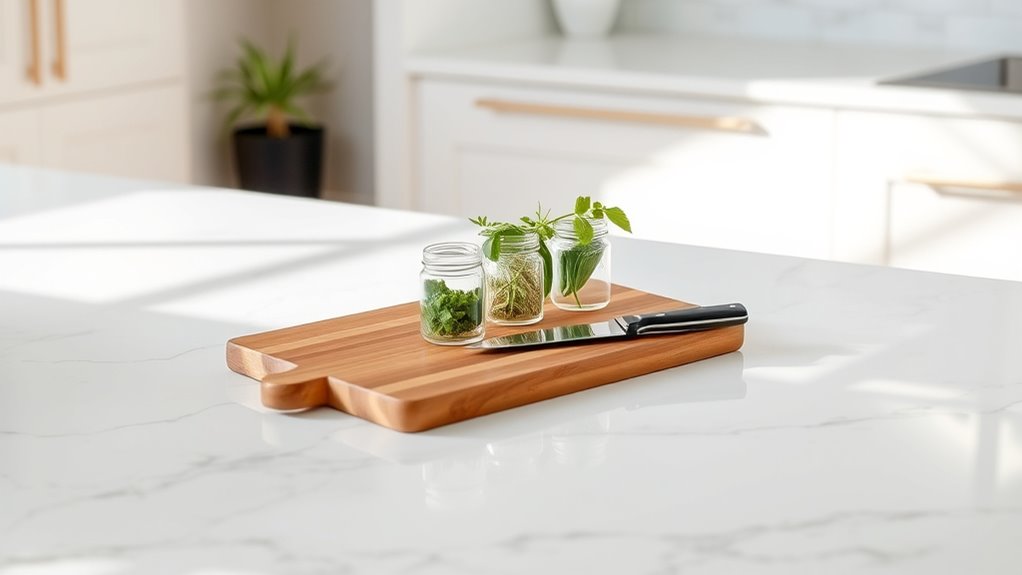To create a minimalist kitchen, start by keeping only essential utensils—two forks, two spoons, and one knife per person. Follow a “one in, one out” rule for items, letting go of something old for every new piece you acquire. Store small appliances out of sight and use open shelves for frequently used items. Regularly check what you haven’t used in six months and let go of it. You’ll discover even more tips as you continue exploring!
Key Takeaways
- Implement a “one in, one out” rule to maintain a clutter-free kitchen and simplify organization.
- Limit utensils to essentials, reducing drawer clutter and simplifying post-meal cleanup.
- Store small appliances in cabinets to keep countertops clear and enhance kitchen spaciousness.
- Showcase indoor plants on shelves for added ambiance and to complement a minimalist design.
- Conduct regular inventory checks every six months to eliminate unused items and maintain functionality.

If you want to create a more organized and peaceful cooking space, adopting minimalist kitchen hacks can make a huge difference. The kitchen is often considered the heart of the home, and maintaining a serene environment can enhance your cooking experience.
To start, implement a “one in, one out” rule for your kitchen items. This simple strategy ensures that for every new item you bring in, you let go of an old one. It’s a practical approach to declutter your kitchen and helps you maintain a minimalist design.
Implementing a “one in, one out” rule helps declutter your kitchen and supports a minimalist lifestyle.
Next, take a hard look at your utensils. Instead of cluttering drawers with an array of forks and spoons, limit your collection to the essentials—two forks, two spoons, and one knife per person. This not only simplifies organization but also makes it easy to clean up after meals. With fewer items, you’ll find that your kitchen feels lighter and more inviting.
When it comes to small appliances, consider storing them in cabinets or the pantry. Keeping your countertops clear enhances the streamlined appearance of your kitchen, making it feel more spacious and open. You can also use open, floating shelves to display frequently used items. This not only keeps your essentials within easy reach but also adds to the airy feel of smaller spaces.
Plus, it gives you a chance to showcase some stylish indoor plants, which can further enhance your kitchen’s ambiance. Adopting these minimalist strategies can also promote emotional well-being by creating a sense of accomplishment and control over your environment.
Regularly performing a six-month inventory check on your kitchen items is another effective way to foster a functional and minimalist environment. During this evaluation, ask yourself what you haven’t used in the past half-year. If it’s been sitting unused, it’s time to let it go.
This practice not only helps you streamline your collection but also ensures that your kitchen remains a space where everything serves a purpose.
Frequently Asked Questions
What Are the Best Colors for a Minimalist Kitchen?
When choosing colors for a minimalist kitchen, you’ll want to focus on a few key shades.
Soft whites and light grays create a clean and spacious feel, while muted earth tones add warmth without clutter.
Consider incorporating accents in muted blues or greens for a touch of color.
Avoid overly bright or dark hues, as they can overwhelm the simplicity you’re aiming for.
Stick to a cohesive palette to maintain that serene, minimalist vibe.
How Can I Maintain a Minimalist Kitchen on a Budget?
To maintain a minimalist kitchen on a budget, focus on quality over quantity.
Start by decluttering your space; get rid of items you rarely use. Invest in a few versatile tools that serve multiple purposes.
Stick to a neutral color palette for a cohesive look, which can save on decor costs. Shop second-hand for furniture and storage solutions.
Lastly, keep surfaces clear to create an open, inviting atmosphere without breaking the bank.
Are There Specific Brands for Minimalist Kitchen Tools?
When you’re looking for specific brands for minimalist kitchen tools, consider options like OXO for versatile gadgets, and IKEA for affordable essentials.
You might also check out Joseph Joseph for innovative designs that save space. For high-quality knives, Wüsthof and Victorinox offer great choices.
How Do I Organize a Small Minimalist Kitchen Space?
To organize your small kitchen space, start by decluttering.
Keep only the essentials you use daily. Invest in stackable containers to maximize vertical space and utilize drawer dividers for utensils.
Hang pots and pans on a wall rack to free up cabinet space. Use clear bins for pantry items to easily see what you have.
Finally, keep your countertops clear to create a more open and inviting atmosphere in your kitchen.
What Are Common Mistakes in Minimalist Kitchen Design?
Designing a minimalist kitchen can feel like juggling eggs—one wrong move, and it all crashes down.
Common mistakes include overcrowding countertops with unnecessary items, choosing poor storage solutions, or failing to consider your workflow. You might also overlook the importance of lighting or neglect to personalize the space, making it feel sterile.
Conclusion
By embracing this minimalist kitchen hack, you’re not just decluttering; you’re creating a symphony of simplicity. Each item you keep plays a vital note in your culinary orchestra, allowing you to whip up meals with ease and joy. Remember, a streamlined kitchen is like a well-tuned instrument—ready to inspire creativity and harmony. So, take a moment to refine your space, and watch how it transforms your cooking experience into a masterpiece of efficiency and delight.









